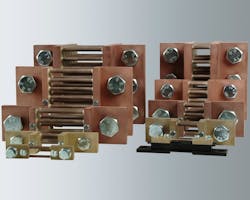Maconic Shunt Resistors
Knick USA, an designer and manufacturer of analog signal conversion technologies, recently introduced its maconic shunt resistors, offering DC current measurements of up to kA range.
Shunt resistors offer reliable, precise, cost-effective and continuous DC current measurements, in applications ranging from photovoltaics, to public transport system power supplies, to inverter DC busses, to welding equipment. The performance capabilities of Knick USA maconic shunt resistors make them sutiable for high-speed circuit breakers (HSCB); high-speed motors and generators; high-voltage battery monitoring; power transmission and switch gears; high-speed electric drives; and demanding DC current Bus measurements.
Each model is size and performance optimized for its intended task, with Class 0.5 and Class 0.2 accuracy. Their rod-based design allows for better heat dissipation, with improved thermal properties for increased overload conditions, all without affecting measurement integrity. Shunt resistor bars are constructed of high-conductivity manganin, allowing for a very low temperature coefficient and higher accuracy.
As a result, Knick resistors only moderately heat until rated current level is reached. The three-port isolated transmitters, rated at 3.6 kV working /15 kV test voltage, provide corresponding high galvanic isolation. While most industry shunt resistors operate at 2/3 of rating, Knick models can be continuously run at 1.2X rated current without performance degradation. Both shunt resistors and isolators achieve years of long-term stability and accuracy. Current peaks do not cause offset or drift.
During operation, current (in Amps) is run through the shunt resistor. That current produces a small voltage output, in millivolts, known as a voltage drop, which is directly proportional to the level of current flow through the shunt. This drop can be read with accuracy and precision by a Knick transducer, which can then send the isolated analog signal to a controller or display for further processing. Shunts are calibrated to the exact amount of voltage drop, usually between 50 mV and 100 mV. Measured currents associated with system voltages (potentials) are galvanically isolated by the shunt isolator. Shunts are available for currents up to 15kA with voltage drops from 50 mV through 300 mV.
Any Knick shunt isolator used along with a Knick transmitter offers a gain error of just 0.1%. Recommended mV transducers and transmitters include the P27000, P2900 and P41000, depending upon required isolation amounts. In addition, Knick USA maconic shunt resistors have an MTBF rating of 96 years for the complete current measurement system.
